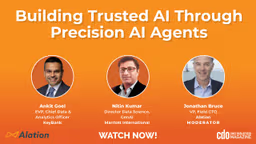Opinion & Analysis
Inside Manulife’s AI Strategy — Chief Analytics Officer on GenAI Use, ROI, and What’s Next
Written by: Pritam Bordoloi
Updated 3:33 PM UTC, Wed February 5, 2025

Jodie Wallis
Canadian financial services provider Manulife has identified over 400 GenAI use cases, with 24 already in production. This has helped the company gain a competitive edge by enhancing efficiency, personalizing customer experiences, and driving innovation in financial services.
Jodie Wallis, Global Chief Analytics Officer at Manulife, attributes this advantage to the company’s early investments in AI, which began nearly a decade ago in 2016. With four years in her current role, she leads Manulife’s global efforts to leverage data and AI for enhanced customer experiences, operational excellence, and strategic decision-making.
In an exclusive interview with CDO Magazine, Wallis explains how Manulife’s advanced analytics capabilities, cloud-native data platforms, and strong executive backing position put the company at the forefront of the GenAI revolution. She also discusses the business impact of its GenAI use cases, the return on investment from these initiatives, talent strategy in the AI era, and the evolving intersection of AI regulations and technological advancements.
Edited Excerpts
Q
How has Manulife’s AI practice evolved since its launch in 2016? What were its initial goals, and what key insights have you gained along the way?
A
We’ve been actively investing in and scaling our AI capabilities since 2016. We have data scientists embedded in all our businesses and functions. Our goal since we started has been to deliver incremental value for our businesses over and above what could be achieved with traditional statistical techniques or automation technologies.
In the last three years, we’ve doubled our value by diversifying our AI solutions portfolio, boosting throughput with data and AI platform investments, all guided by our responsible AI framework and principles.
With the introduction of mainstream LLMs, we have expanded the scope of our AI practice with an emphasis on democratizing AI use across the company. Today, our 38,000 colleagues have access to ChatMFC, our internal AI Knowledge Agent, as well as prompt engineering training, workshops, and communities of practice.
Q
Your organization has identified over 400 GenAI use cases. Can you share more about them? What stages are they in, which business areas do they cover, and how do you determine which ones to pursue?
A
Our strategy is to develop globally scalable solutions locally. We take a disciplined approach to GenAI deployment — prioritizing value first, ensuring reusability and scalability, and ultimately reimagining workflows beyond point solutions.
Our current use cases are focused on three key areas:
1. Cost savings:
-
Intelligent document processing
-
Multi-language translation
-
Automated call and action summarization
2. Revenue growth:
-
Sales agent enablement
-
Marketing content generation
3. Productivity:
-
Code and test generation
-
AI research assistants
-
Compliance
Q
From mining insights from call transcripts in Canada to enabling personalized scripts in Singapore – Can you articulate the value/ROI of these initiatives?
A
Our GenAI capabilities are reshaping the way we do business. With the combination of off-the-shelf and home-grown applications built to help us securely and quickly launch prioritized GenAI use cases across our business, we are creating better experiences for our customers and our colleagues.
For instance, our Mass Market Call Summarization tool helps colleagues focus on customer needs by reducing time spent documenting calls. In the U.S., this has yielded 44 seconds Average Handling time for our US Retail group, and has delivered $45 million in benefits.
In our U.S. Annuities call center, we’ve deployed a complex contract lookup solution, which to date has led to more efficient average handling times. Previously, customer service agents had to navigate multiple systems to retrieve policy information, state regulations, and contract details. This process was time-consuming.
With GenAI, agents now receive immediate answers, improving response speed and accuracy. We supplement the responses with sources to provide clear explanations for the answers, as well as a confidence score from the AI model. This has now been rolled out to eight additional contact centers that handle 110 million calls annually, and we will deploy across additional contact centers in 2025.
Likewise, across Singapore, Japan in Asia, and in the U.S. and Canada, our Sales Enablement Tool equips agents with personalized scripts and emails relevant to their customers, thanks to a combination of GenAI and intelligent lead generation. It literally pulls up talking prompts based on someone’s profile, life stage, and even current events. We were so excited to put this solution in the hands of over 2,000 agents in 2024. This initiative has generated $4.7 million in benefits.
Q
Given the increasing complexity of data landscapes, how are you overcoming the challenges of integrating data from multiple sources and tools to drive customer-centricity?
A
One of the most crucial factors for AI success, perhaps the most important, is efficient access to both internal and, in certain cases, external data. We have invested in a cloud-native data and analytics platform, with robust data governance capabilities.
We will continue to consolidate our structured and unstructured enterprise data onto the platform so that it is available for analytics and AI with the appropriate access control and privacy protocols in place.
Moreover, our global data and AI platform lets us build and scale models efficiently, and at the same time deliver increasingly personalized experiences to our customers and advisors in both our digital and assisted channels. It also lets us spot trends and patterns in customer interactions that inform how we prioritize new and improved customer capabilities.
Q
How has the AI surge affected your talent strategy? And how are you approaching upskilling/reskilling for AI across the organization?
A
It’s no secret that there is a fierce battle for AI talent in the marketplace. We focus on providing our data scientists and ML engineers with great project work, modern tool sets, and a culture where curiosity and innovation are rewarded. We also provide opportunities for them to collaborate with our academic partners.
As for our colleagues, we understand that adopting GenAI can feel overwhelming for some. That’s why we prioritize accessibility and upskilling for all 38,000 employees, equipping them with the resources, guidance, and confidence to harness the full potential of GenAI in their daily work.
We’ve created a communications hub with learning resources, deployment updates, GenAI inventory, and success stories. Additionally, we’ve launched a Prompt-a-Thon workshop and are building a global GenAI community of practice. Moreover, ChatMFC adoption has reached 36%, with over 1,000 new users monthly.
Q
Recent industry reports suggest a possibility of regulations choking GenAI implementation. What is your take on it and how does Manulife’s AI Principles come into play here?
A
Our AI Principles guide how we design, develop, and deploy AI solutions. These principles empower our organization to deliver value for our customers, colleagues, and society.
Managing model risk is also a critical priority, and we have established a comprehensive approach that covers every phase of the model lifecycle. We have implemented multiple layers of safeguards to ensure our models are accurate, fair, and reliable.
With the fast pace of change in AI, we will continue to evolve control frameworks as we learn and grow, as the industry matures, and as new or updated regulations emerge.





